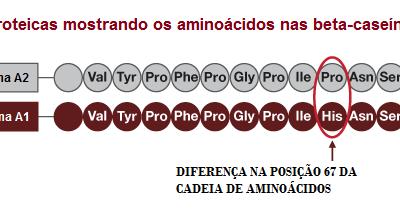
When they discuss milk, the world seems divided into different factions: who tells us that the milk it is healthy and indispensable; those who tell us that, at least, it is not harmful; and the increasingly numerous faction of those who affirm that animal milk is not suitable for human consumption and would indeed be harmful.
To these factions another one is added, which tells us that milk "would" be useful to the body, if it were the right one, because the milk they sell us is not. Let's go into specifics.
Research on milk produced in Europe and betacasein
Some researchers and cow milk producers would have made interesting discoveries about the evolutionary history of dairy cows, which on a chemical level translates into the so-called difference between betacasein A1 and betacasein A2.
It seems that between 5000 and 10000 years ago all the cows produced milk containing beta-casein A2, when suddenly a mutation occurred that pushed one of them to produce a milk rich in beta-casein A1; L'human being, who was able to absorb A2 milk easily, would not yet have fully adapted his body to metabolize A1 milk, which would have some side effects and would not be considered completely healthy.
It all began in the 1s, when some researchers focused on why some digestive problems related to milk consumption were so widespread. In New Zealand it was found that these chronic discomforts were mostly related to the beta-casein AXNUMX protein.
Basically the casein they are complex phosphoproteins, which require specific enzymes to be metabolized and, apparently, while the human digestive system has evolved to produce enzymes suitable for digesting betacasein A2, it would not be able to successfully digest betacasein A1.
Nowadays, due to trade conflicts, various independent researches have been launched and, although there is no evidence that the consumption of A1 milk is certain to relate to type 1 diabetes, it seems true that many discomforts related to the consumption of A1 milk are due to the absence of enzymes capable of dissolving beta-casein A1.
More recent studies would show that some A1 milk digestive wastes would be toxic or, at the very least, unhealthy, specifically, they would cause oxidation of the tissues, inflammation of the blood vessels and would have an antagonistic action towards insulin, favoring the onset of diabetes.
Although some oxidative problems of this kind, linked above all to cardiac deficits, are linked to the consumption of milk tout-court and not only to A1 milk, there is a slight difference between A1 and A2 milk which would favor the consumption of the latter.
The popularity of these studies, the interest of public opinion and the marketing of A2 milk as a brand is growing, so much so that even in Europe, especially in France and the United Kingdom, more and more breeders are replacing their livestock by favoring cows capable of producing type A2 milk.
The response of the authorities
Although some authorities, including the European Food Safety Authority, are still somewhat skeptical on the matter, some states have supported these studies and milk from cows capable of producing A2 milk is marketed and distributed in some of them; we are talking first of all about Australia, New Zealand, China, the United States.
In Europe, with the exception of France, the marketed milk is produced by type A1 cows, the strain not suitable for human consumption, hence the speculations on economic interests that push these states to reject the theses and sector studies, according to among other things, there would be an evident correlation between consumption of A1 milk and the incidence of type 1 diabetes in children.
Africa and Asia are still rich in cows capable of producing A2 milk, as the mutation that prompted cows to produce A1 milk occurred in northern Europe.
Milk substitutes: here are what they are


























